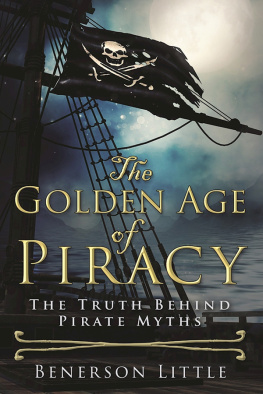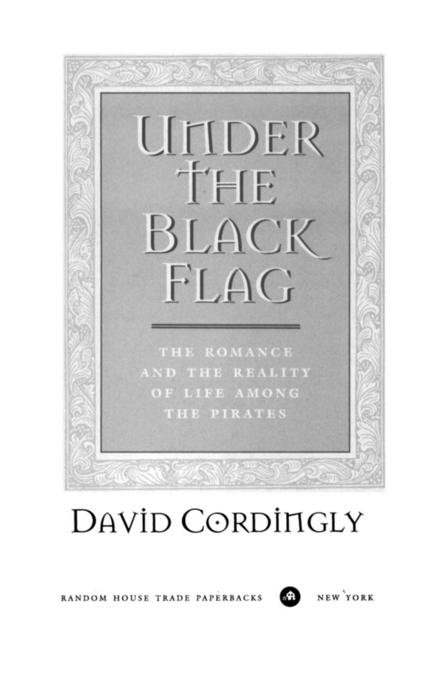PRAISE FOR
U NDER THE B LACK F LAG
Folks who began reading about pirates in their childhood (remember Long John Silver and Captain Hook?) have no reason to stop now. Under the Black Flag provides a satisfying and salty overview of nautical badmen (and a few women too) going back some 500 years.
Parade
Cordingly provides some fresh insights into the rough democracy of pirate life.
The New York Review of Books
An excellent description of the methods, means of recruitment, way of life and generally dismal ends of the pirates who flourished from the sixteenth to the end of the eighteenth century.
The Boston Globe
Even if you dont know a corsair (a Mediterranean-based pirate) from a buccaneer (a Caribbean pirate), this book will delight and inform.
Publishers Weekly
[This] expert and deftly written history of the golden age of piracy effortlessly expands its scope to become social, cultural, literary, and even cinematic history, through which Steven Spielberg and J. M. Barrie wander shoulder to shoulder with Blackbeard and Captain Morgan. Cordingly brilliantly and engagingly demonstrates how myths are formedand how very much we live by them.
C ALEB C ARR , author of The Alienist
A distinguished specialist in maritime history has written a fascinating narrative. Informative, engrossing.
Booklist
A vivid account of the glory days of buccaneers.
Civilization
2006 Random House Trade Paperback Edition
Copyright 1996 by David Cordingly
Maps copyright 1995 by Alec Herzer
All rights reserved.
Published in the United States by Random House Trade Paperbacks, an imprint of The Random House Publishing Group, a division of Random House, Inc., New York.
R ANDOM H OUSE T RADE P APERBACKS and colophon are trademarks of Random House, Inc.
Originally published in hardcover in the United States by Random House, an imprint of The Random House Publishing Group, a division of Random House, Inc., in 1996.
Library of Congress Cataloging-in-Publication Data
Cordingly, David.
Under the black flag: the romance and reality of life among the pirates / David Cordingly.
p. cm.
Includes bibliographical references.
eISBN: 978-0-307-76307-5
1. Pirates. I. Title.
G535.C635 1995 95-41414
910.45dc20
www.atrandom.com
v3.1
P REFACE AND
A CKNOWLEDGMENTS
In May 1992 an exhibition entitled Pirates: Fact and Fiction opened at the National Maritime Museum in London. It was scheduled to last four months but proved so popular that it remained open for three years. The exhibition was organized by my colleague John Falconer and myself, with help from many members of the museum staff and support from a great number of contributors. Exhibits included artifacts from the sunken pirate city of Port Royal, Jamaica; Captain Kidds privateering commission from the Public Record Office; fine portraits of Robert Louis Stevenson and William Dampier from the National Portrait Gallery; Byrons manuscript copy of The Corsair; the Peter Pan costume worn by Pauline Chase in the 1909 London production, and the pirate costumes worn by Dustin Hoffman and Bob Hoskins in Steven Spielbergs film Hook; W. S. Gilberts annotated prompt copy of The Pirates of Penzance; pieces of eight, ducats, and doubloons from the British Museum; and charts, weapons, logbooks, ship models, and buccaneer journals from the National Maritime Museum.
As a result of the widespread publicity which accompanied the opening of the exhibition I was approached by Suzanne Gluck of the New York literary agents ICM, and urged to write a book which contrasted the fictional image of piracy with the reality. I would like to thank Suzanne for starting me on a most enjoyable project, and to record my debt to Ann Godoff, my editor at Random House, who persuaded me to transform my first manuscript into a book which will, I hope, have a wider appeal beyond those interested in maritime history. I am grateful to Alan Samson and Andrew Gordon at Little, Brown, my publishers in England, for helping me to clarify my thoughts in a number of areas. I would also like to record my thanks to Giles OBryen, Clinton Black, Gillian Coleridge, John Falconer, Enrica Gadler, William Gilkerson, Alec Herzer, Helga Houghton, Kevin McCarey, David Marley, Julia Millette, Dian Murray, Peter Neill, Richard Pennell, Linda Silverman, and Norman Thrower, as well as the staff at the Library of Congress, the British Library, the Institute of Jamaica, the London Library, the Public Record Office, and my former colleagues at the National Maritime Museum. Above all I would like to thank my wife and family for their encouragement, advice, and numerous suggestions during the preparation of this book and the exhibition which preceded it.
The sources used in the text are given in the Notes and Bibliography at the end, but I would like to acknowledge my particular debt to four books which I would recommend to anyone wishing to pursue the subject in more depth. The first is Robert Ritchies book Captain Kidd and the War Against the Pirates, which must be the most thoroughly researched and documented book on the life of a pirate ever written. The second is Marcus Redikers Between the Devil and the Deep Blue Sea. Apart from its revelations about the life of the ordinary seaman, this contains a penetrating analysis of the Anglo-American pirates in the early eighteenth century. The third is The Sack of Panama by Peter Earle, which features a vivid and balanced account of Sir Henry Morgans expeditions, and is based on research in the Spanish archives. The fourth is Nicholas Rodgers The Wooden World. This scarcely mentions pirates but provides an extraordinary insight into how the Royal Navy worked and what went on above and below deck. In quoting from seventeenth- and eighteenth-century manuscripts and printed books, I have followed Rodgers example and used modern spelling, punctuation, and capitalization. I have only broken this rule when it seemed to me that the original spelling and use of abbreviations provided additional information about the writer and the circumstances under which the document was written.
D.C.
Brighton, Sussex
February 1995
C ONTENTS
L IST OF M APS
I NTRODUCTION
Pirates have always been elusive figures. They came out of the blue. They attacked, they looted, and they vanished. They left no memorials or personal belongings behind. A few journals provide glimpses of pirate life, but the woodcuts and engravings which illustrate the early histories of piracy are as fictitious as the many stories of buried treasure. And yet the lack of physical evidence has not lessened their mysterious attraction. Reason tells us that pirates were no more than common criminals, but we still see them as figures of romance. We associate them with daring deeds on the Spanish Main, with rakish black schooners and tropical islands and sea chests overflowing with gold and silver coins.
Most of us will never meet any pirates, and yet we know, or we think we know, exactly what they looked like. We learned about them when we were children. We have seen them on the stage and screen. They are as recognizable as cowboys, and like cowboys, they have acquired a legendary status. They have inspired some of the finest writers of the English language, and two pirate stories in particular,







